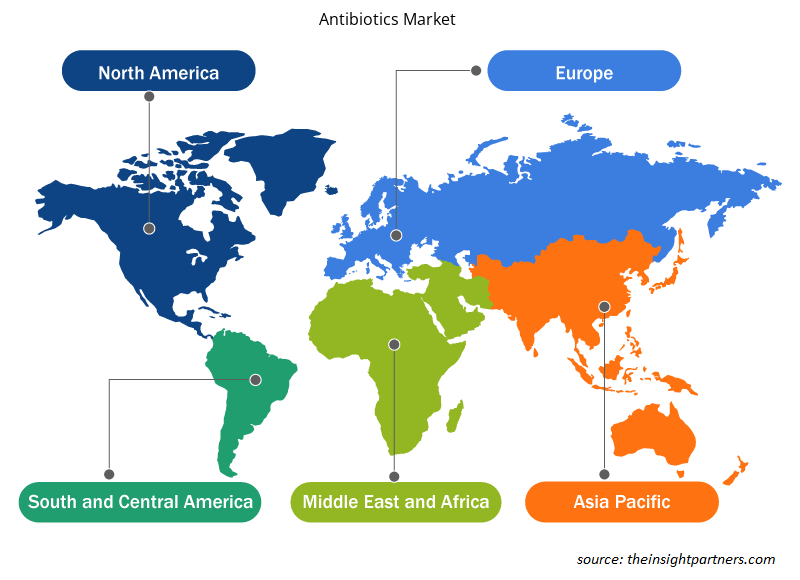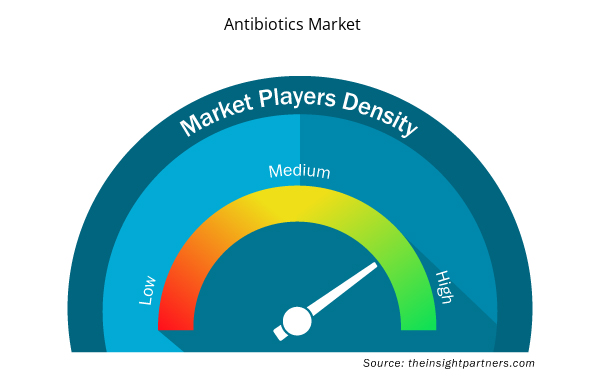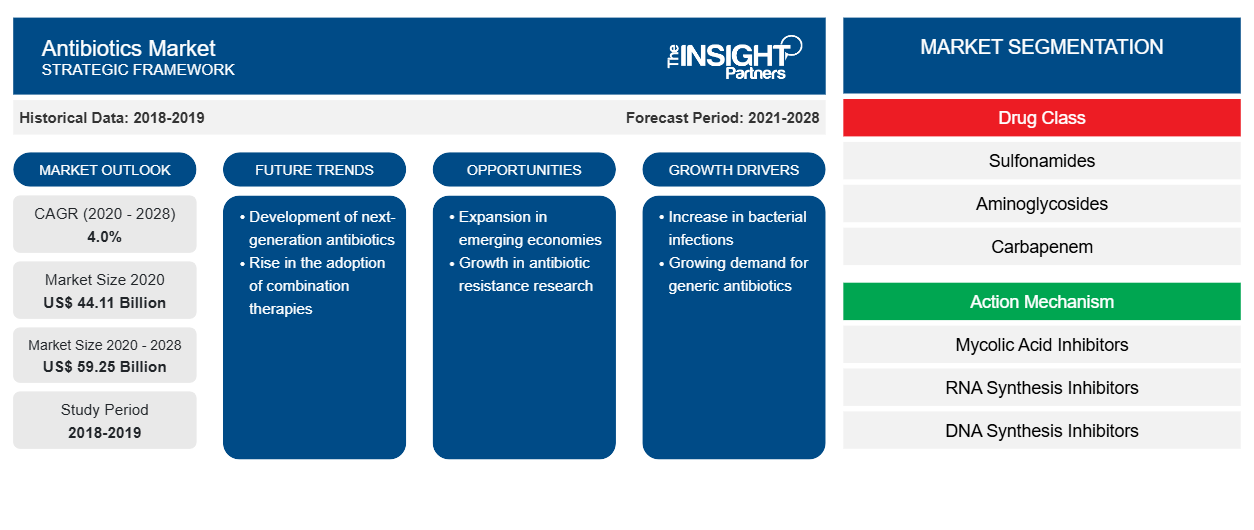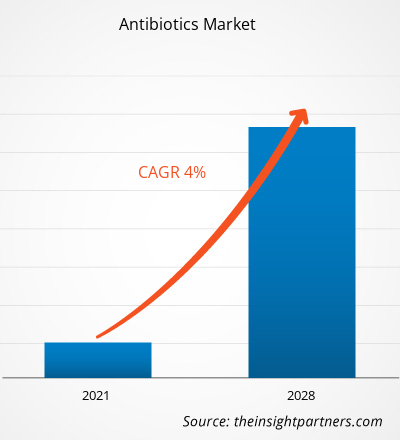Il mercato degli antibiotici è stato valutato a 44.111,31 milioni di dollari nel 2020 e si prevede che raggiungerà i 59.253,24 milioni di dollari nel 2028; si prevede che crescerà a un CAGR del 4,0% nel periodo 2021-2028.
Gli antibiotici sono potenti farmaci usati per combattere infezioni e malattie batteriche. Sono usati specificamente per curare infezioni causate da batteri come Staph., Strep. o E. coli. Gli antibiotici uccidono i batteri (battericidi) o ne impediscono la riproduzione e la crescita (batteriostatici). Il mercato degli antibiotici non funziona contro nessuna infezione virale. Alcune delle infezioni comuni trattate con antibiotici sono congiuntivite, infezione della pelle o dei tessuti molli, infezione delle vie respiratorie superiori, bronchite, faringite streptococcica (mal di gola) e tra le altre.
Approfondimenti di mercato
Sviluppo crescente di farmaci generici
Un medicinale generico è una copia di un farmaco di marca che non è più coperto da brevetto. Le versioni generiche vengono introdotte sul mercato con l'obiettivo di offrire farmaci convenienti e aumentare la portata di questi farmaci per le persone appartenenti a classi economiche diverse. Le versioni generiche sono popolari per la loro disponibilità e convenienza. Ad esempio, secondo uno studio pubblicato sul NCBI nel 2018, il prezzo medio di una prescrizione di marca era quasi 4 volte il prezzo medio generico. Inoltre, le aziende si stanno anche concentrando sullo sviluppo di versioni generiche con l'obiettivo di offrire antibiotici a costi minimi. Ad esempio, a giugno 2018, Lupin ha lanciato la soluzione inalatoria generica di Tobramicina nel mercato statunitense. Inoltre, si prevede che anche l'incoraggiamento delle autorità governative stimoli la produzione di antibiotici generici, che alla fine guideranno la crescita del mercato degli antibiotici durante il periodo di previsione. Ad esempio, a febbraio 2019, la Food and Drug Administration (US FDA) degli Stati Uniti ha annunciato l'approvazione per la commercializzazione di medicinali generici prodotti da aziende farmaceutiche indiane negli Stati Uniti.
Personalizza questo report in base alle tue esigenze
Riceverai la personalizzazione gratuita di qualsiasi report, comprese parti di questo report, o analisi a livello nazionale, pacchetto dati Excel, oltre a usufruire di grandi offerte e sconti per start-up e università
- Scopri le principali tendenze di mercato in questo rapporto.Questo campione GRATUITO includerà analisi di dati che spaziano dalle tendenze di mercato alle stime e alle previsioni.
Informazioni sul tipo di test
In base alla classe di farmaci, il mercato degli antibiotici è segmentato in sulfonamidi, aminoglicosidi, carbapenemi, macrolidi, fluorochinoloni, penicillina, cefalosporina e altri. Il segmento delle cefalosporine ha detenuto la quota maggiore del mercato nel 2020; mentre si prevede che il segmento dei fluorochinoloni registrerà il CAGR più elevato nel mercato durante il periodo di previsione.aminoglycosides, carbapenem, macrolides, fluoroquinolones, penicillin, cephalosporin, and others. The cephalosporin segment held the largest share of the market in 2020; whereas the fluoroquinolones segment is anticipated to register the highest CAGR in the market during the forecast period.
Approfondimenti sul meccanismo d'azione
In base al meccanismo d'azione, il mercato degli antibiotici è stato segmentato in inibitori dell'acido micolico, inibitori della sintesi di RNA, inibitori della sintesi di DNA, inibitori della sintesi proteica e inibitori della sintesi della parete cellulare. Il segmento degli inibitori della sintesi della parete cellulare ha detenuto la quota maggiore del mercato nel 2020, mentre si stima che il segmento degli inibitori della sintesi di DNA registrerà il CAGR più elevato nel mercato durante il periodo di previsione.
Le aziende adottano comunemente strategie di lancio e approvazione dei prodotti per espandere la propria presenza e il proprio portafoglio prodotti in tutto il mondo e soddisfare la crescente domanda.
Gli operatori di mercato che operano nel mercato degli antibiotici adottano la strategia di espansione per ampliare la base clienti in tutto il mondo, il che consente anche agli operatori di mantenere il loro marchio a livello globale. Ad esempio, a luglio 2019, un'azienda come Pfizer ha lanciato un consorzio di ricerca internazionale per scoprire e sviluppare nuovi antibiotici per la TB in collaborazione con otto partner biotecnologici e accademici europei.
Approfondimenti regionali sul mercato degli antibiotici
Le tendenze regionali e i fattori che influenzano il mercato degli antibiotici durante il periodo di previsione sono stati ampiamente spiegati dagli analisti di Insight Partners. Questa sezione discute anche i segmenti e la geografia del mercato degli antibiotici in Nord America, Europa, Asia Pacifico, Medio Oriente e Africa e Sud e Centro America.

- Ottieni i dati specifici regionali per il mercato degli antibiotici
Ambito del rapporto sul mercato degli antibiotici
| Attributo del report | Dettagli |
|---|---|
| Dimensioni del mercato nel 2020 | 44,11 miliardi di dollari USA |
| Dimensioni del mercato entro il 2028 | 59,25 miliardi di dollari USA |
| CAGR globale (2020 - 2028) | 4,0% |
| Dati storici | 2018-2019 |
| Periodo di previsione | 2021-2028 |
| Segmenti coperti | Per classe di farmaci
|
| Regioni e Paesi coperti | America del Nord
|
| Leader di mercato e profili aziendali chiave |
|
Densità degli attori del mercato: comprendere il suo impatto sulle dinamiche aziendali
Il mercato degli antibiotici sta crescendo rapidamente, spinto dalla crescente domanda degli utenti finali dovuta a fattori quali l'evoluzione delle preferenze dei consumatori, i progressi tecnologici e una maggiore consapevolezza dei benefici del prodotto. Con l'aumento della domanda, le aziende stanno ampliando le loro offerte, innovando per soddisfare le esigenze dei consumatori e capitalizzando sulle tendenze emergenti, il che alimenta ulteriormente la crescita del mercato.
La densità degli operatori di mercato si riferisce alla distribuzione di aziende o società che operano in un particolare mercato o settore. Indica quanti concorrenti (operatori di mercato) sono presenti in un dato spazio di mercato in relazione alle sue dimensioni o al valore di mercato totale.
Le principali aziende che operano nel mercato degli antibiotici sono:
- Pfizer, Inc
- Johnson & Johnson Services, Inc. (prodotti farmaceutici Janssen),
- Abate,
- Società per azioni GlaxoSmithKline
- Sanofi,
Disclaimer : le aziende elencate sopra non sono classificate secondo un ordine particolare.

- Ottieni una panoramica dei principali attori del mercato degli antibiotici
Mercato globale degli antibiotici – per classe di farmaci
- Cefalosporina
- Penicillina
- Fluorochinoloni
- Macrolidi
- Carbapenemi
- Aminoglicosidi
- Sulfonamidi
- Altri
Mercato globale degli antibiotici – Per meccanismo di azione
- Inibitori della sintesi della parete cellulare
- Inibitori della sintesi proteica
- Inibitori della sintesi del DNA
- Inibitori della sintesi dell'RNA
- Inibitori dell'acido micolico
- Altri
Antibiotici globali – Per area geografica
America del Nord
- NOI
- Canada
- Messico
Europa
- Francia
- Germania
- Italia
- Regno Unito
- Spagna
- Resto d'Europa
Asia Pacifico (APAC)
- Cina
- India
- Corea del Sud
- Giappone
- Australia
- Resto dell'Asia Pacifica
Medio Oriente e Africa (MEA)
- Sudafrica
- Arabia Saudita
- Emirati Arabi Uniti
- Resto del Medio Oriente e Africa
Sud America
- Brasile
- Argentina
- Resto del Sud America
Profili aziendali
- Pfizer, Inc
- Johnson & Johnson Services, Inc. (prodotti farmaceutici Janssen),
- Abate,
- Società per azioni GlaxoSmithKline
- Sanofi,
- Novartis AG,
- La Bayer AG,
- Società Bristol Myers Squibb,
- Eli Lilly e la società,
- Astellas Pharma
- Analisi storica (2 anni), anno base, previsione (7 anni) con CAGR
- Analisi PEST e SWOT
- Valore/volume delle dimensioni del mercato - Globale, regionale, nazionale
- Industria e panorama competitivo
- Set di dati Excel


- Semiconductor Metrology and Inspection Market
- Latent TB Detection Market
- Analog-to-Digital Converter Market
- Machine Condition Monitoring Market
- Microcatheters Market
- Explosion-Proof Equipment Market
- Dry Eye Products Market
- Pharmacovigilance and Drug Safety Software Market
- Intraoperative Neuromonitoring Market
- Queue Management System Market

Report Coverage
Revenue forecast, Company Analysis, Industry landscape, Growth factors, and Trends

Segment Covered
This text is related
to segments covered.

Regional Scope
North America, Europe, Asia Pacific, Middle East & Africa, South & Central America

Country Scope
This text is related
to country scope.
Domande frequenti
Antibiotics are powerful medicines that are used to fight against bacterial infections. Antibiotics are also known as antibacterials which include a range of powerful drugs and are used to treat diseases caused by bacteria. These are specifically used to treat infections caused by bacteria such as, Staph., Strep., or E. coli. and either kill the bacteria (bactericidal) or keep it from reproducing and growing (bacteriostatic). The antibiotics do not work against any viral infection. Some common infections treated with antibiotics are, conjunctivitis, skin or soft tissue infection, upper respiratory tract infection, bronchitis, streptococcal pharyngitis (strep throat) and among others.
The North American region holds the largest market for the breast cancer screening. The United States held the largest market for antibiotics market and is expected to grow due to factors such as increasing number of rising in prevalence of breast cancer , growing developments for screening and imaging process by the companies and others.
The growth of the market is attributed to some key driving factors such as rising prevalence of bacterial infections, growing geriatric population and increasing development of generic drugs. However, tedious and expensive process of antibiotic development is expected to restraint the growth of the market during the forecast years.
Trends and growth analysis reports related to Life Sciences : READ MORE..
The List of Companies - Antibiotics Market
- Pfizer, Inc
- Johnson & Johnson Services, Inc. (Janssen Pharmaceuticals),
- Abbott,
- GlaxoSmithKline Plc,
- Sanofi,
- Novartis AG,
- Bayer AG,
- Bristol Myers Squibb Company,
- Eli Lilly and Company,
- Astellas Pharma
The Insight Partners performs research in 4 major stages: Data Collection & Secondary Research, Primary Research, Data Analysis and Data Triangulation & Final Review.
- Data Collection and Secondary Research:
As a market research and consulting firm operating from a decade, we have published and advised several client across the globe. First step for any study will start with an assessment of currently available data and insights from existing reports. Further, historical and current market information is collected from Investor Presentations, Annual Reports, SEC Filings, etc., and other information related to company’s performance and market positioning are gathered from Paid Databases (Factiva, Hoovers, and Reuters) and various other publications available in public domain.
Several associations trade associates, technical forums, institutes, societies and organization are accessed to gain technical as well as market related insights through their publications such as research papers, blogs and press releases related to the studies are referred to get cues about the market. Further, white papers, journals, magazines, and other news articles published in last 3 years are scrutinized and analyzed to understand the current market trends.
- Primary Research:
The primarily interview analysis comprise of data obtained from industry participants interview and answers to survey questions gathered by in-house primary team.
For primary research, interviews are conducted with industry experts/CEOs/Marketing Managers/VPs/Subject Matter Experts from both demand and supply side to get a 360-degree view of the market. The primary team conducts several interviews based on the complexity of the markets to understand the various market trends and dynamics which makes research more credible and precise.
A typical research interview fulfils the following functions:
- Provides first-hand information on the market size, market trends, growth trends, competitive landscape, and outlook
- Validates and strengthens in-house secondary research findings
- Develops the analysis team’s expertise and market understanding
Primary research involves email interactions and telephone interviews for each market, category, segment, and sub-segment across geographies. The participants who typically take part in such a process include, but are not limited to:
- Industry participants: VPs, business development managers, market intelligence managers and national sales managers
- Outside experts: Valuation experts, research analysts and key opinion leaders specializing in the electronics and semiconductor industry.
Below is the breakup of our primary respondents by company, designation, and region:

Once we receive the confirmation from primary research sources or primary respondents, we finalize the base year market estimation and forecast the data as per the macroeconomic and microeconomic factors assessed during data collection.
- Data Analysis:
Once data is validated through both secondary as well as primary respondents, we finalize the market estimations by hypothesis formulation and factor analysis at regional and country level.
- Macro-Economic Factor Analysis:
We analyse macroeconomic indicators such the gross domestic product (GDP), increase in the demand for goods and services across industries, technological advancement, regional economic growth, governmental policies, the influence of COVID-19, PEST analysis, and other aspects. This analysis aids in setting benchmarks for various nations/regions and approximating market splits. Additionally, the general trend of the aforementioned components aid in determining the market's development possibilities.
- Country Level Data:
Various factors that are especially aligned to the country are taken into account to determine the market size for a certain area and country, including the presence of vendors, such as headquarters and offices, the country's GDP, demand patterns, and industry growth. To comprehend the market dynamics for the nation, a number of growth variables, inhibitors, application areas, and current market trends are researched. The aforementioned elements aid in determining the country's overall market's growth potential.
- Company Profile:
The “Table of Contents” is formulated by listing and analyzing more than 25 - 30 companies operating in the market ecosystem across geographies. However, we profile only 10 companies as a standard practice in our syndicate reports. These 10 companies comprise leading, emerging, and regional players. Nonetheless, our analysis is not restricted to the 10 listed companies, we also analyze other companies present in the market to develop a holistic view and understand the prevailing trends. The “Company Profiles” section in the report covers key facts, business description, products & services, financial information, SWOT analysis, and key developments. The financial information presented is extracted from the annual reports and official documents of the publicly listed companies. Upon collecting the information for the sections of respective companies, we verify them via various primary sources and then compile the data in respective company profiles. The company level information helps us in deriving the base number as well as in forecasting the market size.
- Developing Base Number:
Aggregation of sales statistics (2020-2022) and macro-economic factor, and other secondary and primary research insights are utilized to arrive at base number and related market shares for 2022. The data gaps are identified in this step and relevant market data is analyzed, collected from paid primary interviews or databases. On finalizing the base year market size, forecasts are developed on the basis of macro-economic, industry and market growth factors and company level analysis.
- Data Triangulation and Final Review:
The market findings and base year market size calculations are validated from supply as well as demand side. Demand side validations are based on macro-economic factor analysis and benchmarks for respective regions and countries. In case of supply side validations, revenues of major companies are estimated (in case not available) based on industry benchmark, approximate number of employees, product portfolio, and primary interviews revenues are gathered. Further revenue from target product/service segment is assessed to avoid overshooting of market statistics. In case of heavy deviations between supply and demand side values, all thes steps are repeated to achieve synchronization.
We follow an iterative model, wherein we share our research findings with Subject Matter Experts (SME’s) and Key Opinion Leaders (KOLs) until consensus view of the market is not formulated – this model negates any drastic deviation in the opinions of experts. Only validated and universally acceptable research findings are quoted in our reports.
We have important check points that we use to validate our research findings – which we call – data triangulation, where we validate the information, we generate from secondary sources with primary interviews and then we re-validate with our internal data bases and Subject matter experts. This comprehensive model enables us to deliver high quality, reliable data in shortest possible time.


 Ottieni un campione gratuito per questo repot
Ottieni un campione gratuito per questo repot